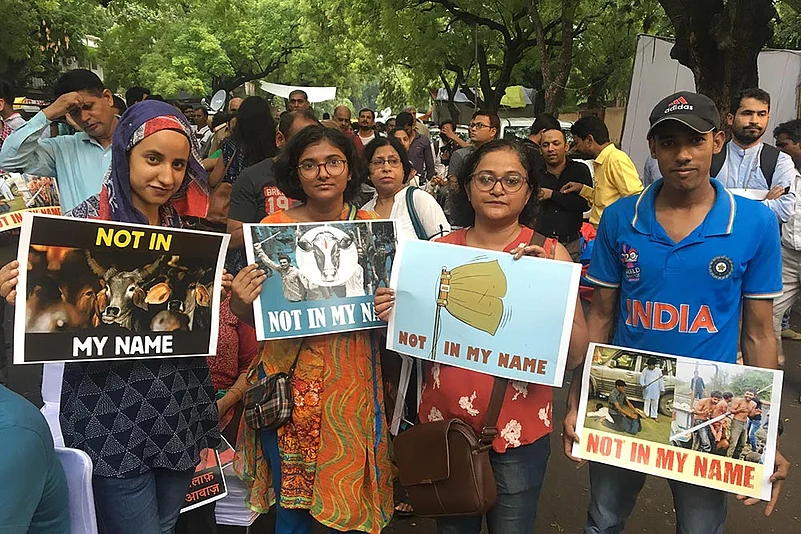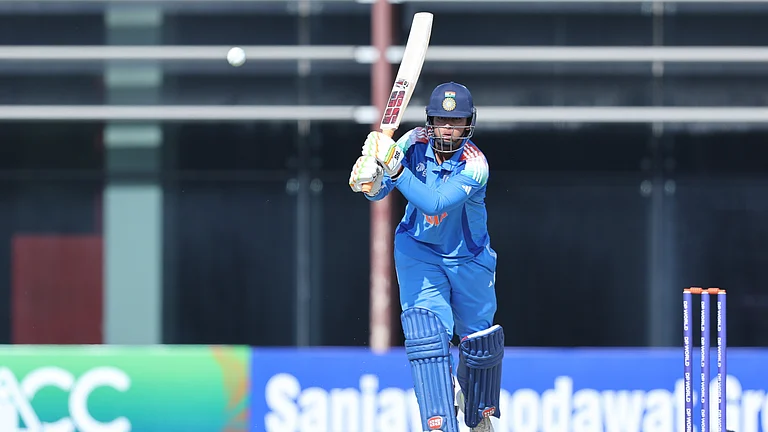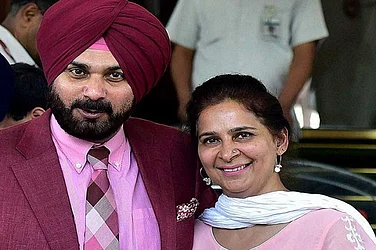After they all went back, drenched in rain and the warm glow of togetherness eked out by strangers converging on a street, there was a jumble of feelings: exhilaration, doubt, acrimony. Born on social media, it retreated back to that space of polemics, endorsed and critiqued in turn. Was it really representative, it was asked. Was it not an elitist, liberal affectation entangled in caste and class, as always? Out there on the street, not without their own doubts, some had come carting their own freight of life’s scars, looking tentatively for comfort in numbers. Nazia was there too on Wednesday, dressed in a salwar-kameez and black hijab, obvious markers of identity.
“I thought there would be fewer people,” says the 32-year-old, scanning the venue from her vantage point: a slushy pavement at Delhi’s Jantar Mantar. The rain-soaked square was chock-a-block with people, hundreds of them, most carrying posters decrying mob violence. The spate of lynchings, which rumbled on even after 15-year-old Junaid’s cold-blooded murder sparked this series of #NotInMyName protests across cities in India, had created a kind of shared horror. The young mother of two had come with low expectations. “I don’t believe things will really change after this protest but still I came, if only to increase the number of attendees by one.”
Nazia’s brother Arslan, 23, is a tall engineer-to-be. They live in Noida, Delhi’s annexe, once a hub of retired bureaucrats and armymen, now infiltrated by corporate honchos, petty traders and realtors—and tend to feel news of this sort, of random violence, on their skin. The siblings say they have seen their city and its people change over the last few years,. “Earlier, I was never conscious of the way I dress; now I sense the people’s gaze,” Nazia says. “They stare at my dress. To them, I appear conspicuously Muslim…someone not to be trusted fully.”
Arslan concurs. The fear of violence is growing, he says, and not just in villages, where the most brutal lynchings have occurred. Even in cities, the vulnerable—Muslims, Dalits, women—are feeling more vulnerable. “Koi bhi kisi ko bhi maar raha hai (anybody is killing whoever they want),” he says. Something baleful seems afoot in the air. His non-Muslim acquaintances still treat him as before but their social media posts, often borderline, make him wonder: “Are they really the same people when I’m not around?” Chimes in Nazia, “People have been fed with violence and anger.” And Arslan: “It is fear that we have come here to fight.”

And so began the moment of protest in Delhi and 12 other cities: Allahabad, Bangalore, Chandigarh, Lucknow, Chennai, Kochi, Jaipur, Patna, Calcutta, Mumbai, Thiruvananthapuram, Kochi. To these, each attendee brought a unique sense of injustice and outrage, very often drawn from personal experience. An intangible something was achieved in thus coming together, almost everyone felt. They also felt the next logical question: what next? Will this lead to a bigger movement or quietly fade?
“What can a mere protest achieve,” asks Saba Dewan, a Gurgaon filmmaker whose Facebook post sparked off the #NotInMyName protests, in India and abroad. “But we say society must not allow these horrible lynchings to be normalised. To people who say hote hi rehte hain—lynching is not unusual—these protests affirm the State’s duty to protect every citizen.” Dewan says the protests were kept deliberately non-partisan for exactly this reason: to stave off accusations of being led by political outfits. “The Congress either did not slam down on the communal card or it played that as well. These protests simply say any ruling party is duty-bound to protect people’s lives,” she says.
The class/caste critique came from various quarters. Some asked whether the hashtag ‘Not in My Name’—reminiscent of the self-exculpating #NotAllMen meme within feminist debates in the US—itself did not imply a position of savarna privilege. For performance artist Sujoy Prosad Chatterjee, who read Sunil Gangopadhyay’s poetry at the Calcutta event, it was simpler: for him the evening symbolised a common humanity against all violence. “Everybody is opposed to killings. That simple point has a moral force nobody can deny,” he says.
There are others who responded to this essential theme. Shiv, a young professional at Jantar Mantar, says he is from the LGBT movement and knows what it’s like to be marginal and facing constant threat. “Whether Dalit or woman or Muslim or gay, I’m here in solidarity against anyone hurt or killed by mobs,” he adds.
Almost everyone has felt the growing impunity with which bizarre terms are imposed on people today. Diktats from different powers—each the king of his anthill—on what to wear, where to go and what not to eat, are slowly wearing them out. Recently, Chatterjee was denied entry at a Park Street restaurant for they thought he had come wearing a lungi, a garment loosely (and wrongly) considered a ‘Muslim attire’. The restaurant was wrong on another count: Chatterjee had actually worn a sarong. “But what if I’d happened to follow Islam and wore a namaz topi and applied kajal like a Musalman and worn a lungi with my shirt?” he asks. “No restaurant can dictate someone’s clothing this way.”
There are, inevitably, charges that the events were peopled by the well-heeled and the ‘Left-liberal’ set. Undoubtedly, in Delhi, the near-absence of ordinary Muslims or the working class was apparent. This wasn’t uniformly true of all cities. Nor did the mere look of the crowd reveal everything about it. “A very rare cross-sectarian, broad-based coalition came together,” says Ali Khan Mahmudabad, who teaches history and political science at Ashoka University. “Shia, Sunni, Sufi, Barelvi or Deobandi didn’t matter. What mattered is uniting against mob violence.” He also links this to a parallel protest that cut through class—when Muslims wore black armbands on Eid across Uttar Pradesh, including in villages.
Mahmudabad points to a generalised tendency to mob violence: recent victims include Ayub Pandith in Kashmir, Hindus in Dadri and Rae Bareli, and Dalits across the map. “Each of these is shocking,” he says. “But each is different too—with Muslims, media the world over has created a perception that they could be terrorists, thus creating a key reason for their being targeted.”
Clinical psychologist Rajat Mitra says the protests managed to gather a wider resonance because recurrent mob violence has touched a “raw chord” among people. “Fear does not make people go out and protest—it makes them shrink. I think people have felt an assault at a primal level, on their identity, on who they are and what they believe. That has spurred them.” There’s another, related aspect: psychologists call it “grief reaction”, which is akin to fear. “Sometimes a nation as a whole no longer knows who it is, what it stands for. This happens when its people feel their identity is being subtly changed. Then they respond in this manner.”
Wearing black armbands and/or showing up for these protests were no simple matter for many Muslims too. Many imams discouraged them. The protests took off only because they became impossible to stop, as if answering an inner need.
Nor did it stop serious soul-searching. Loose talk of beef, for one, which is what had accompanied Junaid’s killing. “People don’t realise that beef, unfortunately, is a very contentious issue in West Bengal today,” says Sarmistha Dutta Gupta, a researcher-activist in Calcutta. “Maybe it’s not as dire as it is in Haryana or Rajasthan but it’s beginning to matter a lot. People need to watch out,” she says. The news of three Muslims killed on cattle-smuggling ‘charges’ in Dinajpur had just broke on June 27. “Calcutta’s beef-sellers are now scared of selling meat openly. They no longer trust unknown buyers,” Sarmistha adds.
Other truths are being driven home. In Bangalore, a city now dominated by immigrants, many are confronting the deep-seated passivity and indifference of peers. “It’s rare for Bangalore to awaken to an incident that occurred so far away. So that’s a big plus,” says Shreyashi, an IT professional. She tried involving friends and colleagues, but only “two out of twenty” were remotely interested or aware of the event. “People here usually don’t want to take anybody on,” she says.
On June 27 night, writer Karthik Venkatesh, who helped organise the protest in Bangalore, was hesitant to predict the turnout. But things changed the next evening. “Over 500 people eventually showed up,” he says. “We also got support from prominent intellectuals like Ram Guha and Girish Karnad. A good start.”
Inevitably, comparisons are also being drawn to the protests sparked by the 2012 Nirbhaya gang-rape and, a year preceding it, the India Against Corruption (IAC) movement. Both spontaneous, both initially apolitical, both rising to a crescendo from within social media spaces (and falling prey to doubts that set in post facto). “Yet another template comparison is possible—with the Bhim Sena, which has organised two well-attended events at Jantar Mantar since May,” says commentator Satish Prakash.
“These days there’s plenty of hype, one wonders if it will lead to something concrete,” says Dr Prem Singh, a Socialist Party leader on hunger strike for a week against violent mobs at Jantar Mantar. For him, hunger strikes are a “form of contemplation”, a chance for both sides to try and find resolution. “Such contemplation does not arise out of hype,” he says. His hunger strike, he says, is to spur society to take “suo motu notice” of violent mobs and their disastrous impact. “People should decide—do we want a constitutional, civilised society or not?”
Gaurav, an accountant from Gurgaon who attended the protest, has similar thoughts. He came out of sheer solidarity with Junaid and his kin but has a larger framework that flows from a personal space. “I too am a Hindu, from Bijnor in UP, where Hindu-versus-Muslim is a big thing. This divide has absolutely no relevance to me. Just like I try to spread that message in my family, I came here.”
But the most fitting sight of resistance—and one unafraid to acknowledge the dark echoes the idea of mob violence generates within her—was of Nirmal Luthra, 92. The Lahore-born retired lecturer, who migrated to India as the horrors of Partition unfolded before her, has strongly supported #NotInMyName. “Not just religion, anybody being targeted for their caste, creed and gender is unacceptable,” she says. “This is not the India we know—we want an India where everybody is happy, no matter what religion, caste or way of life.”


























